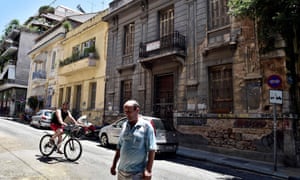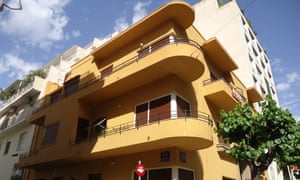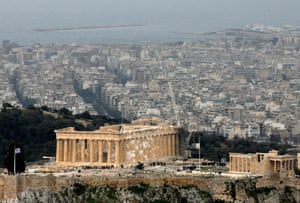Forget the Parthenon: how austerity is laying waste to Athens’ modern heritage
A full 80% of 19th and early 20th-century buildings in the Greek capital have already been destroyed, and time is running out for what’s left.
Not that long ago I received a questionnaire through my door. How had the 1930s Bauhaus building in which I live survived the rigours of time? Who had designed it? Who was its first owner? And, the form went on, what were my memories of it?
Circulated far and wide across Athens, the questionnaire and its findings are part of a vast inventory of 19th- and early 20th-century buildings that now stand at the heart of a burgeoning cultural heritage crisis in Greece. At least 10,600 buildings are on the database and it is growing by the day.
Against a backdrop of economic recession – the price of three gargantuan bailouts to keep the debt-stricken country afloat – home maintenance has become a luxury few can afford. With bank loans frozen and cuts and tax increases straining budgets, many of the buildings have been allowed to fall into disrepair, or have been pulled down altogether.
“In the present climate, people just don’t have the money to restore them,” says Irini Gratsia, co-founder of Monumenta, the association of archaeologists and architects that is collating the database. “There is a great danger that many will be demolished not because their owners want new builds, but because they want to avoid property taxes announced since the crisis began.”
Just as they say Greece is not only Athens, the history of Athens is not only about the Parthenon
Monumenta estimates that, since the 1950s, as many as 80% percent of Athens’ buildings from the 19th and early 20th centuries have been destroyed.
Now at risk are some of the last surviving examples of Greek neoclassical architecture and Greek modernism, the latter scorned as “cement boxes” when they began to fill the great Attic plain. Mostly constructed between 1830 and 1940, they comprise the rich architectural mosaic of a city – dominated by the 5th-century Acropolis – that often goes unnoticed.

“Just as they say Greece is not only Athens, the history of Athens is not only about the Parthenon,” says Nikos Harkiolakis, a veteran culture ministry official who now heads an organisation representing owners of listed buildings.
But the destruction of Athens’ urban space is not new. More than any other major European metropolis, the Greek capital has been altered dramatically by the vicissitudes of its tumultuous modern history.
The Bauhaus apartment blocks, like the one in which I live, were constructed in the 1930s, when modernism – reflecting social upheaval at the time – suddenly exploded. The handwritten deeds on my building, set out across 11 stamped pages of elegant handwritten scrawl, name its first owner, in 1934, as Panagiotis Merzotis, a merchant who owned two shops on its ground floor. According to a hand-drawn floor plan, the building abutted Ottoman and Roman ruins in the Plaka district beneath the Acropolis. Each of its three apartments measured 142 sq m – a typical size for the interwar years, when a vibrant generation of poets, painters and a mercantile middle class favoured modernist architecture for its elevators and central heating.
The rapid urbanisation that followed a brutal German occupation during the second world war saw edifices both neoclassical and modern torn down almost overnight.

Mine emerged unscathed – although, because of its proximity to the Parthenon, with which Hitler was obsessed, it did not entirely escape the tyranny of the Third Reich. On the morning of 27 April 1941, the tanks, motorbikes and cars of the Wehrmacht streamed into the square in Plaka in which it stands, turning the area into a depot; German military staff took over the top floor of the building.
The civil war that followed caused yet more damage – still visible in the chipped, bullet-pocked facades.
These building are an invaluable part of Greece’s architectural heritage and an integral part of the history of Athens
Even more damaging, however, was what came next. From the 1950s, under legislation since criticised as shortsighted and controversial, Athenians were encouraged to hand over their family homes in exchange for apartments in the multi-storey concrete blocks that replaced them. In the 60s and 70s, rural migration led to chaotic urban expansion as Athens was transformed into a megacity that now hosts up to half of Greece’s entire population.
The Athens of imposing neoclassical edifices – architecture first adopted with the arrival of the court of King Otto, the German-born monarch installed by Greece after it achieved independence from the Ottoman empire – has been virtually erased.
“If a building wasn’t classified a ‘work of art’, it stood to be demolished, and up until 1975 at least one was destroyed every week,” says Harkiolakis. “Those that survived are the very last to exist; they are architectural gems that must be supported.”
Among those still standing in the city centre is a five-storey neoclassical building on Tsakalof Street that has been in the family of Spyros Mercouris for five generations. The 92-year-old belongs to one of Athens’ most prominent families: his grandfather was the mayor at the turn of the 20th century; his sister, Melina, was an actor and culture minister. But that has helped little in his ongoing battle to renovate the building’s facade. The task has been made harder by the fact that the building, like many others in Athens, and since been split into separately owned flats.
“Navigating the labyrinthine bureaucracy has been a nightmare,” says Mercouris, who acted as his sister’s adviser in the 1980s when, as culture minister, she saved 182 buildings in Plaka that were at the point of collapse. “From the outset it has been a labour of love.”

Nikos Continis owns an 1870s two-storey neoclassical home in the graffiti-covered district of Exarcheia. “Doing anything to the place is hugely costly, hugely time-consuming and seemingly neverending,” he says. “Getting permits to move ahead with any work can take years – and that’s before anything you may want to do is approved by the government.”
Roughly a third of Monumenta’s database is comprised of listed buildings. Not all were constructed in the neoclassical spirit favoured by the Bavarian planners brought in by Otto to transform what was then a malaria-ridden village of no more than 5,000 residents. Many belonged to the school of eclectic architecture inspired by art nouveau and art deco – trends that would influence the architecture of most US cities in the 1920s and 30s.
Apartment buildings inspired by the Bauhaus movement but given a Greek twist – with shuttered windows and enclosed balconies – proliferated across the capital as the bourgeoisie shunned neoclassical design for modern comforts. With their simplified designs, ornately decorated ironwork, delineated motifs and spacious marble halls, they are considered masterpieces in their own right.
Le Corbusier, the Swiss architect widely viewed as the pioneer of the modern movement, particularly influenced leading Greek architects.
“All these buildings are the legacy of architects who had studied in places like Paris and Germany and worked in the offices of men like Le Corbusier,” says Gratsia. “They are an invaluable part of Greece’s architectural heritage and an integral part of the rich history of Athens.”











